20 Tips For Creating An Awesome Dry Climate Garden
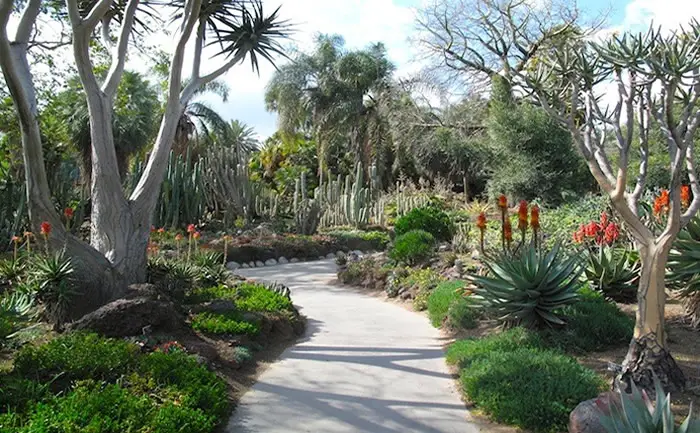
Gardening in a dry climate is considered by many to be more of an art than a science. However, using some sound scientific principles creating a beautiful natural garden is a possibility. Your success will be determined by how well you pre-plan your garden features as well as your availability to a regular fresh water source.
Table of Contents
- 20 Tips For Creating An Awesome Garden In A Dry Climate
- 1. Planning the garden before planting is key
- 2. Make sure your garden has access to some water
- 3. Choosing the right plants for your climate is crutial
- 4. Choose plants that have tolerance levels within your climate extremes
- 5. Check your soil’s pH value
- 6. Once you know the basics it’s time to envision the garden
- 7. Make a list of suitable plants for your soil & climate
- 8. Pick plants based on their water needs as well
- 9. Drought plants will thrive in a dry climate garden
- 10. Consider planting by root type
- 11. Plan the layout
- 12. Be strategic in your garden planning
- 13. Use shade to your advantage
- 14. Use any available gradient for better water flow
- 15. Consider making some minor soil improvements where necessary
- 16. Utilize raised beds for isolating plants & using specialized soil
- 17. Use troughs, channels & pebbles to help plants grow healthy roots
- 18. Block the wind to give your plants better protection
- 19. Create shade to protect vulnerable plants from too much direct sun
- 20. Be careful with your choose of container for potted plants
- Quick 5 Point Recap For Gardening In A Dry Climate
20 Tips For Creating An Awesome Garden In A Dry Climate
You must do some basic research before you begin planting. This is never more often than it is with a dry climate garden.
Before you even look at a flower or plant, first familiarize yourself with your own local environment, its soil and its climate.
1. Planning the garden before planting is key
Although it’s true that creating a lush garden in a wetter climate is much easier than trying the same in a dry climate you really can create some spectacular scenery no matter how hot your back yard gets. But before you buy even one seed it is important you have a well thought-out and workable plan for each of your garden’s features.
The hanging gardens of Babylon, of ancient times, was a perfect example of how Man can turn an arid, dry landscape into a thing of “natural” beauty. The gardens are said to be have been built by King Nebuchadnezzar II in 600 B.C and were created in an environment much like modern day Arizona.
The lush gardens were the wonder of the ancient world and their scale and splendor can be truly appreciated by the fact that we still talk about them today.
However the arid dry climate of the ancient Babylonians was only made to bloom through their incredibly detailed planning. If you wish to make your own “desert” bloom you need to to follow their example. After all if they could build and maintain hanging gardens in the desert thousands of years ago what is to stop you from creating your own Babylonian masterpiece in this age of science and advanced technology?
2. Make sure your garden has access to some water
No matter what type of plant you decide to include in your garden it will need water.
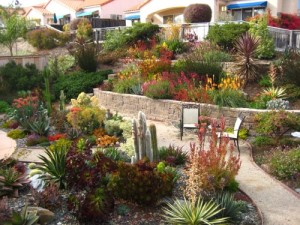 This may seem like an obvious statement but many great gardens have suffered, and even died, due to the planting of water hungry plants in a water challenged environment.
This may seem like an obvious statement but many great gardens have suffered, and even died, due to the planting of water hungry plants in a water challenged environment.
So although you do not necessarily need an abundance of water you will need access to at least a small water supply that you can tap into whenever you want.
In addition to ensuring you have an adequate water supply you will also need to ensure you choose the correct plants for your climate, soil type and general growing environment.
3. Choosing the right plants for your climate is crutial
Having access to an abundant and constant flow of fresh water means you have a much larger choice of plants.
However, living in a dry climate seriously reduces those choices. It doesn’t mean it reduces your ability to create color, contrast, beautify, fragrance and style though.
For every group of wet climate flowers that are chosen for color, fragrance or aesthetic appeal there is at least one alternative (albeit different in nature) that will thrive in a dry climate.
So, although you may not have the same range of plants to choose from you can still create the same color schemes and layout as any other garden.
In fact if you choose the correct drought-tolerant plants you can even have a green garden all year round. Experienced gardeners have even created their own, romantic gardens in the desert which traditionally require a more wet and moderate climate.
The following are some expert tips that will help you to make the most of your dry climate garden.
4. Choose plants that have tolerance levels within your climate extremes
The most obvious thing to take into consideration is the weather in your area. Specific plants thrive best in specific climates so before you start hunting the best desert blooms be sure to know your annual temperature ranges.
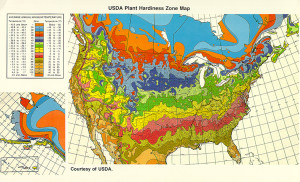
Do not worry too much if you have your heart set on a particular plant or flower that requires a cooler or wetter environment than the one you can provide it.
As long as the plant can survive in climates that are not at the extremes of your environment (several degrees either way) there are specific steps you can take to make the environment more tolerable for that plant. For example, you can create shaded areas and using wind breakers and placing them strategically where they will get more water (as outlined below).
5. Check your soil’s pH value
Have you checked the pH value of your soil? There are simple kits available from Amazon that will allow you to do this easily.
Picking the best plants for your garden will be a lot easier when you know which plants are best suited to your soil.
You can check which seeds and seedlings are the best match for your soil’s pH value by inquiring with the seller or through a simple Internet search.
If you are buying packeted seeds this information should be displayed on the label.
6. Once you know the basics it’s time to envision the garden
It isn’t just NASA astronauts and Olympic athletes that can take advantage of visualization!
Just as astronauts and athletes will visualize specific exercises to help themselves prepare for training and upcoming events, you can use the same process to help you prepare your dry climate garden.
Create a vision of the way you would like your garden to look.
When you have a mental blueprint (or even a visual one) of the colors and layout of your garden it will be fairly easy to find a plant, flower of shrub that fits that vision and is well suited to your soil.
7. Make a list of suitable plants for your soil & climate
Gather up a large list of plant types that will thrive in your garden, based on the local climate, your soil’s pH value and your water availability. Don’t forget to include plants for their scent as well as their overall look and color.
Once you have a large list of suitable foliage you can start to mix and match them so they will resemble your vision as closely as you can get it.
Oftentimes you will find that you get new ideas from this approach and your garden will end up looking, and smelling, even more spectacular than you had first envisioned.
In dry climate areas succulents are usually the best type of plant to cultivate in the garden.
8. Pick plants based on their water needs as well
How much water will you need?
When choosing plants be sure to bear in mind your water situation.
You must identify plants that best suit your ability to feed them water.
For this reason it is always best to air on the side of caution and where possible choose a plant that will thrive on little water.
9. Drought plants will thrive in a dry climate garden
Here is a small list of plants that do well in dry conditions:
- Amaranth
- Bromeliads
- Brachychitons
- Tepary beans or beans that belong to the “cowpea” family
- Quinoa
Culinary and curative herbs also grow very well in dry conditions and can add a subtle fragrance to your garden.
Additionally, there are some fruits and edibles that are well adapted to arid conditions.
Some of them include:
- Olives
- Currants
- Gooseberries
- Grapes
Frangrance can be gleaned from a myriad of dry-loving plants such as:
- Eucalyptus
- Perennials
- Clematis
For a more comprehensive list of plants that thrive in drought conditions visit the Australian educational site Acs.edu.au.
10. Consider planting by root type
There are some plants that have shallow roots and thus require less watering while others have deep root systems that require a bigger quantity of water to reach down to quench their thirst.
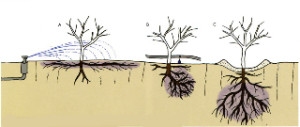 This is especially important if you are growing potential food stuff.
This is especially important if you are growing potential food stuff.
To cope with dry conditions most desert plants, such as succulents like cacti, have shallow root systems.
When choosing a desert or dry climate plant it will almost always have a shallow root system.
Below I have included a short list of vegetables that are either shallow root or deep root in nature. These are examples.
Obviously you will likely want to plant flowering perennials and mix things up with different plant types.
The following vegetables are examples only. Do your research into the type of roots on the plants you previously identified and added to your list.
Shallow-root vegetable include:
- Beets
- Chard
- Green beans
- Lettuce
If you choose to use some plants with deep root systems be sure to follow the advice about keeping water-hungry plants together.
The list of such plants is too extensive for this article so below are some vegetables that can survive in dry environments as long as they are watered regularly and given enough water to reach their roots.
Deep-root vegetables include:
- Asparagus
- Corn
- Melons
- Rhubarb (resistant to drought by not great in very warm climates)
- Squashes
- Tomatoes
By grouping shallow root and long root plants together you can avoid over-watering or under-watering in any one place. This is especially useful in environments where water is at a premium.
Obviously this rule-of-thumb should also be applied to the other plant types you plan to include in your garden, not just to vegetables.
11. Plan the layout
When matching plants to the overall vision of how you want your garden to look try your best to group plants together according to their water needs.
Consider adding edible plants to your garden as well as those that are pleasing the eye.
Nothing tastes better than a home grown vegetable.
If you have trouble visualizing how certain plants will look together you will be happy to know that there are free online tools that do it for you.
You simply upload a photo of your garden and and can add different plants to different areas to see how they will look – think of it as a gardener’s Photoshop.
12. Be strategic in your garden planning
The positioning of your plants is not just about their water needs!
Position your plants strategically by making sure you place your thirstiest plants in places where the sunshine reaches them earlier in the day instead of noon or late afternoon when it is warmer.
By protecting these kinds of plants from excessive sunshine and heat you will greatly reduce the amount of water they need.
This will also allow you to experiment with the growing of plants that would not normally be a good fit for your environment.
13. Use shade to your advantage
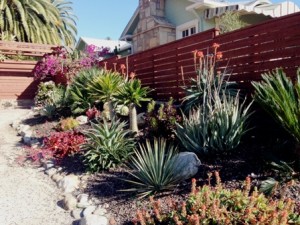 If possible position thirsty plants in areas that are shaded during the hottest part of the day in summer.
If possible position thirsty plants in areas that are shaded during the hottest part of the day in summer.
When first planting, or if using containers, position your seedlings close to each other in order to maximize on moisture and shade.
14. Use any available gradient for better water flow
Make gravity work for you by putting lower-water-demand plants at the top and higher-water-demand plants at the bottom of a slope.
Position plants growing on sloping ground so that the most water-hungry are at the bottom where they can take advantage of water overflow.
15. Consider making some minor soil improvements where necessary
You do not have to be stuck with inferior soil. Make improvements to the soil wherever possible.
To improve drainage and water retention, dig deep and loosen the soil before applying large amounts of organic matter, such as compost, to enrich the growing layer.
If you are using pots or other containers you can retain and conserve water by lining them using sphagnum moss or similar.
16. Utilize raised beds for isolating plants & using specialized soil
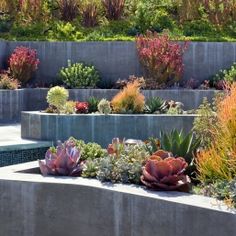 A common occurrence in dry climates is that of have highly alkaline soil and caliches (cement-like calcium carbonate layers). These types of soils can be challenging to even the most experienced and hardest of gardeners.
A common occurrence in dry climates is that of have highly alkaline soil and caliches (cement-like calcium carbonate layers). These types of soils can be challenging to even the most experienced and hardest of gardeners.
If you are in an area with shallow caliche layer then you are likely to have healthier growths if you use raised beds.
You can also populate the raised beds with non-local soil mixes that are better suited to the plants that you want to grow.
Raised beds also make it easier to regulate hydration and fertilization of specific plants without affecting other plants that have different care requirements.
17. Use troughs, channels & pebbles to help plants grow healthy roots
Make furrows besides rows of plants in order to hold and channel water to their roots.
Alternatively, you can use pebbles to build troughs around the plants.
Though it is unlikely to happen due to water restrictions if you do have an abundant water source be sure that the plants are never totally submerged.
18. Block the wind to give your plants better protection
Use wind obstructions if possible. A great way to do this is to plant windbreak shrubs or trees – like the Texas Mountain Laurel.
Blowy weather in dry arid climates and drought areas will kick up a lot of dust that can dry out your soil.
If the area you are growing your garden in is windy, think of planting windbreaks. to not only protect the upper part of your plants but to also slow down water loss in the soil through wind induced evaporation.
19. Create shade to protect vulnerable plants from too much direct sun
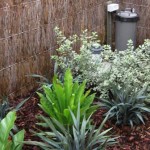 There are some areas, and in particular at high altitudes, where the intensity of the sun can be a huge challenge for gardeners.
There are some areas, and in particular at high altitudes, where the intensity of the sun can be a huge challenge for gardeners.
However, this does not have to be a deal-breaker when it comes to growing plants and it is even possible to grow cooler season plants by simply erecting a shelter with shade cloth.
20. Be careful with your choose of container for potted plants
Choose your containers prudently. There are some containers that lose moisture faster than others.
Terracotta pots may be popular but they are among those that will lose moisture more rapidly than alternatives. The moisture-wicking effect that takes place with terracotta makes these pots the best for growing succulents indoors in many non-tropical climate zones, as this creates higher humidity levels, but it is less than ideal in a dry climate garden.
Instead of using the traditional terracotta go for containers that offer an in-built watering system.
If using a container without a separate base you should also place a large saucer, or similar, under each pot to collect excess water.
You can get some great ideas for creative containers here.
Quick 5 Point Recap For Gardening In A Dry Climate
Here are some quick tips to help you create the garden of your dreams regardless of how hot your garden’s environment is or how little water your plants have access to.
1. Start with the soil and work from there
The foundation for every good garden lies in the soil. A good garden that will withstand drought starts with a well-amended soil.
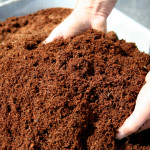 In drought-like areas you need to help the soil in your garden by adding a lot of rich, organic compost. Apart from helping to trap moister, it also encourages strong root development in plants.
In drought-like areas you need to help the soil in your garden by adding a lot of rich, organic compost. Apart from helping to trap moister, it also encourages strong root development in plants.
Consider using biochar. Biochar is a highly porous charcoal that is helpful when it comes to soil fertility. It also helps the soil to retain water. But according to many experts even this is not enough.
Some experts believe even the best laid plans and best efforts will probably prove fruitless if you fail to “mulch”.
Mulch is used in a variety of garden types but is useful in a dry climate in order to lessen evaporation and water overflow. In addition to adding a degree of moisture retention a heavy carpet of mulch will curb weed growth and thus lessen the impact of water shortages as weeds will compete with your plants for water and also nutrients.
2. Plant to beat the heat
Be smart about your planting regime.
Regardless of what is on the label consider planting and seeding a few weeks earlier than normal to beat the heat. This is especially true if you plan to use plants that are best suited to wetter and cooler environments.
If you are trying to grow plants that are normally found in places that have fairly cool temperatures all year round be sure to plant them in the winter. If you are growing these plants from seed keep them refrigerated for a few weeks prior to sowing in order to mimic the winter cycle of cooler climates.
3. Avoid clumping when you plan out your dry climate garden
Although rows of plants look beautiful, they are not very water efficient. Too many plants close together have to fight for resources and this can eventually leave patches of damaged or dying foliage in areas where resources are scarce.
This is why you should plant your garden in a block style layout instead of rows. This will help you when you want to create microclimates, shaded areas and when you want to control water distribution and lessen water evaporation.
Design the layout of your garden in a way where the plants with the same water requirements are placed in one group as mentioned earlier. Regularly review the quantity of plants and quality of the plants in each block and do not be afraid to cull some.
Reducing plant numbers may not be ideal but doing so will help the remaining plants stay healthy. If you leave them all to fend for themselves this action could lead to the death of the entire block.
4. Know when you need water and when you don’t
If you follow my advice and plant any “wet-loving” plants before the recommended time period your plants will have sufficient time to develop their root systems and this will help them to survive the future hotter days.
During their growth your plants will require deep watering to help them develop strong healthy roots in the soil. Special attention at the early stages will help you grow much more sturdy plants that need less tending when resources thin out in warmer months.
It is recommended that you deploy a drip system as it will distribute water evenly over a sustained period. Surprisingly this will usually cut your water consumption, sometimes by up to 50%.
If the soil is amended as explained above it can then go from 2-7 days without needing any tending.
5. Chose your plants wisely
You should research the development stages and their requirements of your chosen plants as each will vary.
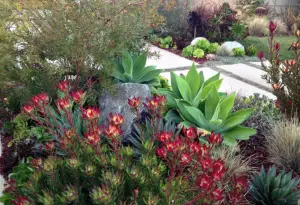 There are certain plants that need less water than others.
There are certain plants that need less water than others.
However be aware that watering is usually critical during a specific stage of growth that may be different for each of your drought-loving plants.
And last but not least use succulents in abundance. Flowering succulent plants range from the interesting, to the beautiful, right down to the outright flamboyant and they all love a warm dry climate.
Thanks for reading! I'm Michael — houseplant fanatic and your Pinterest plant guide.
Follow me on Pinterest for fresh updates 🌿



